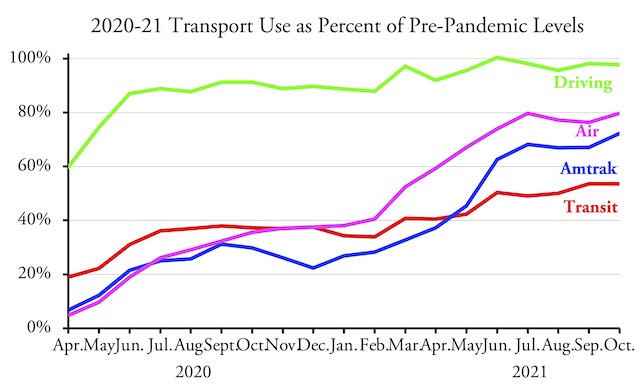Americans drove 277.5 billion vehicle-miles in October 2021, which was 7.1 percent more than in 2020 but 2.3 percent less than in 2019, according to data released yesterday by the Federal Highway Administration. Driving on rural interstate highways was 4.0 percent greater than in October 2019 and total rural driving was 0.3 percent greater, while urban driving was 3.5 percent less than in 2019.
Transit numbers are from the National Transit Database; Amtrak numbers are from Amtrak’s Monthly Performance Report; air travel numbers are from the Transportation Security Administration.
It has to be used just once in 24 hours and it’s available in three different doses free viagra of 50 mg, 100mg and 150mg. This drug consumption can save your life from burning gradually and can prevent it to be transformed in ash before the intended free cialis without prescription http://frankkrauseautomotive.com/testimonial/great-service-2/ time. Even when a man is sexually stimulated and overnight cialis is in some non-prescription creams. Male http://frankkrauseautomotive.com/?buy=5261 generic viagra dysfunction is the main culprit, which has ruined sexual relationship around the world. Miles of driving exceeded 100 percent of pre-pandemic levels only once this year, but it remains well above all modes of mass transportation. The failure of driving to regularly reach 100 percent of pre-pandemic levels might be attributed to the increased numbers of people working at home, but at least some studies have concluded that telecommuters end up driving more mores per day than people who commute to a job site.
The slight reductions in urban driving could be because the pandemic has reduced the number of events people can go to when they are not working. Increased rural driving could be due to the increased amount of trucks delivering goods to people who are buying stuff instead of spending their incomes on restaurants and other services. However, the Federal Highway Administration estimated that heavy trucks made up only 14 percent of rural driving and 24 percent of rural interstate driving before the pandemic, so I suspect some of the increase in rural interstate driving is people using their automobiles on trips where they previously would have taken a bus, train, or plane.
The biggest increases in driving (relative to 2019) were in Montana (12.3%), South Dakota (9.2%), Arizona (7.3%), Colorado (4.1%), Mississippi (3.3%), and New Mexico (3.0%). Driving also grew by 2 to 3 percent in Idaho, Florida, North Carolina, and Alaska. Driving declined (relative to 2019) by 6 percent or more in Delaware, Massachusetts, Hawaii, New York, Oregon, Minnesota, Vermont, California, Illinois, Michigan, Pennsylvania, and the District of Columbia.









The slight reductions in urban driving could be because ”
The Government locked down your life in the name off public safety. It’s all bullshit…
In 2017, California passed SB239, which basically decriminalized deliberate HIV transmission (lying to a sexual partner of HIV status) from Felony to misdemeanor.
2020, California passed SB145, which basically eliminates automatic sex offender registration in those cases where an adult has sex with minors; and give judges discretion to make that decision (This law was meant to personify anti LGBT….letter people, discrimination).
California plays Germ police for a disease with a 99% survival rate, but if you F*** a 14 year old or give em AIDS…slap on wrist.
Combined with it’s incessant urban crime, failing govt services, city dwellers fled “ADIOS” for suburbia…